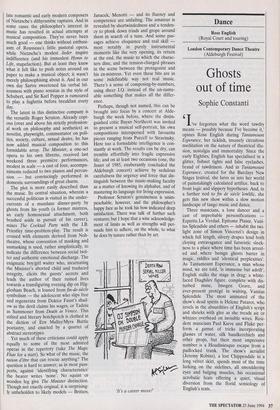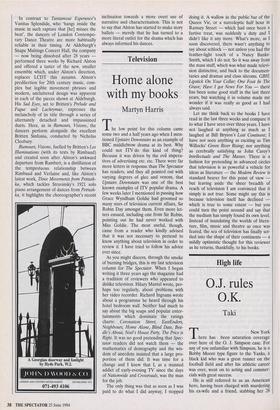Dance
Rose English (Royal Court and touring)
Ghosts out of time
Sophie Constanti
I've forgotten what the word tawdry means — possibly because I've become it,' opines Rose English during Tantamount Esperance, her ticklish, insanely circuitous meditation on the nature of theatrical illu- sion, nostalgia and immortality. Since the early Eighties, English has specialised in a glitter, fishnet tights and false eyelashes, brand of tawdriness. And in Tantamount Esperance, created for the Barclays New Stages festival, she lures us into her world of painstakingly calculated artifice, back to front logic and slippery hypotheses. And, in a further nod to fin de siecle lowlife, she gets this new show within a slow motion landscape of tango music and dance.
Three musicians, a lone dancer and a cast of improbable personifications Espiritu La Verdad, Epitome Plaisir, Vani- tas Splendide and others — inhabit the twi- light zone of Simon Vincenzi's design in which full length, silvery drapes lend both cloying extravagance and futuristic sleek- ness to a place where time has been arrest- ed and where benign ghosts barter in magic, riddles and 'identical perplexities'. As Tantamount Esperance, a man whose mind, we are told, 'is immense but adrift', English stalks the stage in drag: a white- faced Diaghilev figure, complete with dis- turbed muse, Imogen Grave, and ever-present protégé in waiting, Vanitas Splendide. The most animated of the show's dead spirits is Helene Patarot, who revels in the absurdities of English's script and shrieks with glee as she treads air or whizzes overhead on invisible wires. Resi- dent musicians Paul Kieve and Fluke per- form a gamut of tricks incorporating glasses of water, silk handkerchiefs and other props, but their most impressive number is a Houdiniesque escape from a padlocked trunk. The show's aerialist (Jeremy Robins), a lost Chippendale in a long velvet skirt, spends most of the time lurking on the sidelines, all smouldering eyes and bulging muscles, his occasional acrobatic feats offering a quiet, visual diversion from the florid semiology of English's texts. In contrast to Tantamout Esperance's Vanitas Splendide, who 'hangs inside the music in such rapture that [he] misses the beat', the dancers of London Contempo- rary Dance Theatre are more habitually reliable in their timing. At Aldeburgh's Snape Maltings Concert Hall, the company — now being dissolved after 28 years performed three works by Richard Alston and offered a taster of the new, smaller ensemble which, under Alston's direction, replaces LCDT this autumn. Alston's predilection for 20th century music, com- plex but legible movement phrases and modern, uncluttered design was apparent in each of the pieces shown at Aldeburgh. His Sad Eyes, set to Britten's Prelude and Fugue and Lachoymae, expresses the melancholy of its title through a series of alternately detached and impassioned duets. Here, as in Rumours, Visions, the dancers perform alongside the excellent Britten Sinfonia, conducted by Nicholas Cleobury.
Rumours, Visions, fuelled by Britten's Les Illuminations (with its texts by Rimbaud) and created soon after Alston's awkward departure from Rambert, is a distillation of the tempestuous relationship between Rimbaud and Verlaine and, like Alston's latest work, Three Movements from Petrush- k a, which tackles Stravinsky's 1921 solo piano arrangement of dances from Petrush- k a, it highlights the choreographer's recent
inclination towards a more overt use of narrative and characterisation. This is not to say that Alston has started to make story ballets — merely that he has turned to a more literal outlet for the drama which has always informed his dances.

































































 Previous page
Previous page